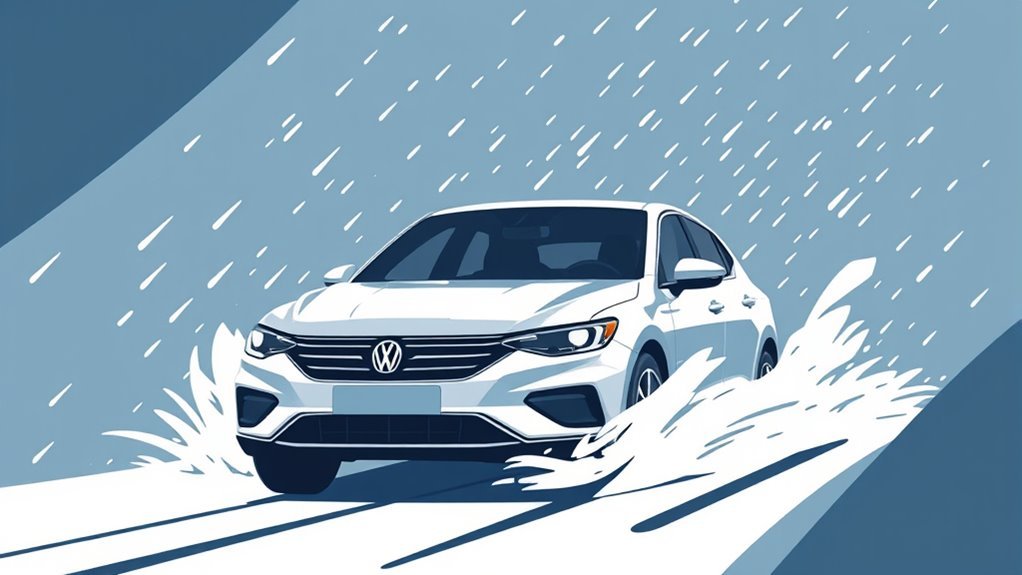Drivers can stay safe during sudden snow and rain squalls by regularly checking local forecasts and alerts. Preparing their vehicles is essential; they should guarantee proper tire tread, functioning wipers, and filled fluids. Adjusting driving techniques, such as reducing speed and maintaining a safe following distance, improves safety. If conditions worsen, drivers must know when to pull over. Staying informed about weather updates can greatly reduce risks during adverse conditions, leading to better safety strategies on the road.
Main Points
- Regularly check local weather updates and alerts to stay informed about sudden changes in conditions.
- Prepare your vehicle by ensuring tires, wipers, and fluids are in optimal condition for adverse weather.
- Adjust driving techniques by reducing speed, maintaining smooth steering, and using lower gears on inclines.
- Increase following distance to five or six seconds to allow for longer stopping times on slippery roads.
- If visibility drops significantly or conditions worsen, find a safe place to pull over until it improves.
Understand Weather Patterns and Alerts
How can drivers effectively maneuver the challenges posed by sudden weather changes? Understanding weather patterns and alerts is essential. Drivers should regularly check local forecasts and utilize weather apps that provide real-time updates. These tools can alert them to sudden changes, such as snow squalls or heavy rain, allowing for timely adjustments in driving plans.
Additionally, familiarizing oneself with the specific weather phenomena common in their region can improve preparedness. For example, recognizing the signs of an impending storm can prompt drivers to seek shelter or avoid travel altogether.
Moreover, understanding the difference between various weather alerts—such as watches, warnings, and advisories—can inform drivers about the severity of conditions they might encounter.
Prepare Your Vehicle for Adverse Conditions

Staying informed about weather conditions is only one aspect of guaranteeing safety on the road; preparing the vehicle itself is equally important.
Drivers should start by checking tire tread depth and guaranteeing proper inflation, as adequate grip is essential during adverse weather. Windshield wipers must be in good condition, with blades replaced as needed to secure visibility in rain or snow.
Additionally, the vehicle's battery should be tested, particularly in colder temperatures, to avoid unexpected failures. Fluids, including antifreeze and windshield washer fluid, should be topped up to tackle varying conditions effectively.
Emergency kits containing items like blankets, flares, and non-perishable snacks can also provide peace of mind during unexpected situations.
Finally, confirming that headlights and taillights are functioning properly can improve visibility during low-light conditions. By taking these proactive steps, drivers can greatly increase their safety when faced with sudden weather changes.
Adjust Your Driving Techniques
A vital aspect of driving safely during sudden weather changes involves adjusting driving techniques. Drivers must remain vigilant and responsive to the shifting conditions. Reducing speed is essential, as slick surfaces can greatly impair traction. It is critical to avoid abrupt maneuvers, such as sharp turns or sudden stops, which can lead to loss of control. Gentle acceleration and smooth steering help maintain stability on wet or icy roads.
Additionally, drivers should use lower gears when descending hills, which can improve vehicle control and reduce reliance on brakes.
Visibility can diminish rapidly, so utilizing headlights, even during daylight, is important to boost awareness.
Finally, drivers should be prepared for the potential of hydroplaning or skidding. If these situations arise, it is essential to remain calm and steer into the slide, allowing the vehicle to regain traction naturally.
Adjusting these driving techniques can greatly improve safety during unpredictable weather conditions.
Maintain a Safe Following Distance

Maintaining a safe following distance is a critical component of driving safely in sudden weather changes. When faced with snow or rain squalls, visibility and traction can diminish rapidly, making it essential for drivers to adjust their spacing from the vehicle ahead. A greater distance allows for ample reaction time, enabling drivers to respond effectively to sudden stops or changes in traffic conditions.
In adverse weather, it is advisable to increase the following distance beyond the standard three-second rule, potentially extending it to five or six seconds. This additional space provides a buffer against potential skidding or loss of control on slippery surfaces.
Drivers should remain vigilant, as weather conditions can change abruptly, impacting stopping distances. By prioritizing a safe following distance, drivers can improve their chances of avoiding collisions, ensuring not only their safety but also the safety of others on the road.
Use Headlights Wisely
When driving in sudden weather changes, using headlights wisely can greatly boost visibility and safety. During snow and rain squalls, reduced visibility is a common challenge. Drivers should verify their headlights are turned on to illuminate the road ahead and improve their presence to other vehicles.
It is important to use low beams in such conditions, as high beams can reflect off precipitation, creating glare that further impairs vision. Additionally, fog lights may be beneficial if equipped, as they provide a wider, closer light that helps illuminate the road without causing excessive glare.
Drivers should also regularly check that their headlights are functioning properly and adjusted correctly, as misaligned lights can reduce visibility. By adopting these practices, drivers can maneuver through sudden weather changes more safely and effectively, minimizing the risks associated with poor visibility during these challenging conditions.
Know When to Pull Over
How can a driver determine the right moment to pull over during sudden weather changes? Evaluating visibility is essential; if it drops considerably due to heavy snow or rain, it may be time to seek shelter.
Drivers should also be aware of road conditions; if the pavement becomes slippery or water begins to pool, the risk of losing control increases.
Additionally, if the driver experiences difficulty maintaining speed or control, pulling over becomes vital. Listening to the vehicle's performance can provide important clues; strange noises or vibrations may indicate unsafe conditions.
Moreover, if other vehicles are struggling or swerving, it is a sign to find a safe stopping point.
Finally, if the driver feels anxious or overwhelmed, it's prudent to stop until conditions improve. Recognizing these signals can help guarantee safety during unpredictable weather events.
Stay Informed and Updated
To guarantee safety during sudden weather changes, drivers must stay informed and updated.
Monitoring weather alerts, utilizing traffic apps, and checking local news can provide vital information that aids in decision-making.
This proactive approach helps drivers steer through challenging conditions more effectively.
Monitor Weather Alerts
Staying informed about weather conditions is crucial for drivers, especially during sudden changes. Monitoring weather alerts can greatly improve safety on the road.
Drivers can take several proactive steps to stay updated:
- Utilize Official Weather Apps: Many apps provide real-time alerts and forecasts tailored to specific locations.
- Listen to Local Radio Stations: These stations often broadcast timely weather updates, especially during severe weather events.
- Check Social Media for Updates: Local authorities and meteorologists frequently share important information on platforms like Twitter and Facebook.
Use Traffic Apps
What if drivers could access real-time information about road conditions during sudden weather changes? Utilizing traffic apps can provide just that advantage.
These applications offer updates on traffic congestion, road closures, and severe weather alerts, helping drivers make informed decisions before and during their journeys. By integrating GPS technology, many apps can also suggest alternate routes to avoid hazardous conditions, enhancing safety.
Additionally, drivers can receive notifications about changing weather patterns, allowing them to prepare accordingly. The ability to stay informed through traffic apps enables drivers to steer safely, reducing the risk of accidents during sudden snow and rain squalls.
In a fast-changing environment, these tools are crucial for promoting awareness and ensuring safer travels.
Check Local News
As weather conditions can change rapidly, checking local news becomes vital for drivers seeking timely updates. Staying informed not only improves safety but also aids in making informed decisions about travel routes.
- Live Weather Reports: Local news stations provide real-time updates on changing weather conditions, warning of sudden snow or rain squalls.
- Traffic Alerts: News outlets often report on accidents and road closures, which can be essential for planning alternate routes.
- Emergency Services Announcements: Local news may convey important information from emergency services, including road safety tips and community advisories.
Common Questions
What Should I Do if I Get Stuck in Snow?
When someone gets stuck in snow, they should remain calm, stay with the vehicle for safety, clear the exhaust pipe, and signal for help while conserving fuel and staying warm until assistance arrives.
How Can I Improve My Tires for Winter Driving?
To improve tires for winter driving, one should consider investing in winter-specific tires, ensuring proper tread depth, maintaining correct tire pressure, and regularly checking for wear. These measures boost traction and comprehensive vehicle control in adverse conditions.
Are There Specific Wipers for Heavy Rain?
When considering wipers for heavy rain, individuals should look for high-performance options designed for such conditions. These wipers typically feature advanced rubber compounds and aerodynamic designs to improve visibility and guarantee effective water removal during downpours.
What Emergency Supplies Should I Keep in My Vehicle?
A well-prepared vehicle should include essential emergency supplies such as a first aid kit, flashlight, water, non-perishable snacks, blankets, jumper cables, and a basic toolkit to guarantee safety during unexpected situations on the road.
How Can I Tell if Road Conditions Are Safe?
Determining road safety involves checking for visible hazards, evaluating traffic flow, and observing weather conditions. Utilizing real-time traffic apps and local news reports can provide essential information regarding potential dangers that may affect driving conditions.

